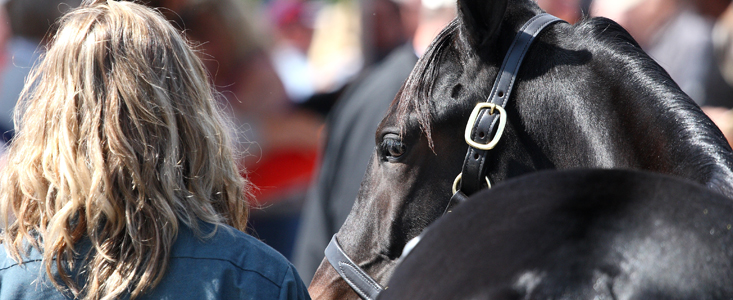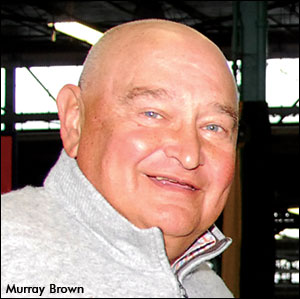Stories from the Trenches

With yearling sales approaching, TROT went searching for unique, behind the scenes stories from North America’s top standardbred sales. Naturally, Murray Brown, Bob Marks and Mike Kimelman, each associated with some of the finest horses ever to race, had no shortage of great tales to share.
By Melissa Keith

When talk turns to Standardbred yearling sales, some of the top breeders in the sport underestimate the uniqueness of their experiences.
“I don’t really have a story, just the regular stuff,” says Hanover Shoe Farms public relations director Murray Brown. “The odd time somebody has bought the wrong horse, and they either put him back in the sale and taken a loss, or on the rare occasion, they made a profit on one the next time it sold.”
But anyone who has helped send as many yearlings through the ring as Brown has definitely had his share of noteworthy moments at the sales. Case in point:
 “We (Standardbred Horse Sales Co.) had a horse several years ago, a trainer bought him for a couple of his clients and then after the sale, one of the clients ran out on him. Subsequently, it took us quite some time to get paid for that horse. And that horse turned out to be Muscle Hill [1:50.1, $3,318,682].”
“We (Standardbred Horse Sales Co.) had a horse several years ago, a trainer bought him for a couple of his clients and then after the sale, one of the clients ran out on him. Subsequently, it took us quite some time to get paid for that horse. And that horse turned out to be Muscle Hill [1:50.1, $3,318,682].”
Has he heard any regret from that would-be client after Muscle Hill became a World Champion and 2009 Horse of the Year? “Oh, lots of it, and he’s periodically reminded of it anytime I see him, and I’m sure when some other people see him,” adds Brown.
Not every great yearling anecdote involves a world champion horse. “We had a filly we sold at Lexington a couple of years ago, she’s a three-year old now. Her name’s Chivaree Hanover and she was about as nasty a filly as you could possibly find,” says Brown. “Anybody who came to look at her was advised of that, that she wasn’t a kid’s horse and she could be dangerous.”
“Gregg McNair eventually ended up buying her for $12,000, and he came to our consignment afterwards and he was wondering why he got her so cheap, and he was told the story — you know, ‘be careful with her!’ He subsequently did a great job with the filly because she went on to be a stakes-winning filly last year. I think she earned (over $100,000) as a two-year old.”
Has Chivaree Hanover metamorphosed into a more personable filly? “I really don’t think so — I think she’s still pretty nasty!” quips the Hanover public relations director. “I went to visit her at The Red Mile last fall. She came right at me with her ears pinned back. It required great horsemanship to get her going and be patient with her, because one like that can easily go the opposite way. We didn’t expect her to bring a whole lot because of that. I was quite surprised, personally, that she made it to the races and, secondly, that she turned out to be the kind of filly that she is.”
Bob Marks has his share of entertaining yearling tales, having helped bring an estimated 2,000-plus colts and fillies to market. “I think probably the most unusual is one we sold as an agent, back in the early ‘90s. The horse’s name was ‘Murray Plumstead.’”
The former Perretti Farms marketing director explains: “Basically what happened was, this was before the time of yearling videos and a lot of other things… with this particular colt, we had no idea what the hell [he] was (talent-wise). One day we had him in the field and they were ponying him because a prospective buyer wanted to see him… the guy was riding the quarter horse in the field and this thing was just trotting - fast! We’re in a small truck following along and this thing is just trotting like the breeze. The quarter horse couldn’t run anymore.”
“At one point the guy who was in the truck with me and the prospective buyer — Pat Waldo, a very well-known and well-respected yearling agent — said, ‘How fast is this truck going?’ Truck was going about 28 miles an hour! That would mean the colt that we were looking at was trotting about a 30 second clip for a quarter, which would be practically a 2:00 mile. He had very little pedigree: he was by Meadow Road, who wasn’t considered a major sire at the time; his mother hadn’t done very much. But he did what we saw.”
 At the sale, Marks told his friend Per Eriksson about Murray Plumstead’s surprising performance. “I said, ‘Per, this SOB can do that!’ He never saw it, but he didn’t get a horse all day. Now this nice, modest, non-descript colt, we thought was going to bring around $10,000, if that. Well, on one side of the arena was Per, who didn’t get a horse all morning, but he’s on the phone with Ted Gewertz, his owner. And on the other side was Pat Waldo, who was buying horses for Arlene Traub at the time, and several other people.”
At the sale, Marks told his friend Per Eriksson about Murray Plumstead’s surprising performance. “I said, ‘Per, this SOB can do that!’ He never saw it, but he didn’t get a horse all day. Now this nice, modest, non-descript colt, we thought was going to bring around $10,000, if that. Well, on one side of the arena was Per, who didn’t get a horse all morning, but he’s on the phone with Ted Gewertz, his owner. And on the other side was Pat Waldo, who was buying horses for Arlene Traub at the time, and several other people.”
“Put it this way: two people went at it, and this colt must have brought $80,000, a colt that you’d have thought would bring ten.” Eriksson placed the winning bid on the colt, who would come to bear the name of Ted Gewertz’s favourite football team. “He’s a rabid New York Giants fan like I am. His Hambletonian winner was named Giant Victory, so as soon as he bought this horse, it was going to be ‘Giant’ something or other,” chuckles Marks.
“The horse became Giant Force, international superstar.”
Giant Force went on to win 17 races, establishing a career trotting mark of 1:54.2. He earned $1.14 million.
Marks may have yearling stories galore, “but there’s a limit to how much of it is really printable!” he adds mischievously. Then he segues into a printable memory about a puzzlingly undervalued filly and a puzzled auctioneer — “I think it was Vernon Martin” (the auctioneer).
“I remember when we had the filly in the ring, the auctioneer, he got so desperate. He’s singing, he’s dancing, and finally in desperation, he throws his hands up and says, ‘Will anybody give me a bid on this horse? I’ll take $500!’” says Marks, breaking into an impromptu impression of the auctioneer. “You know how they sing: ‘Who’ll give me five-hunnerd? Five-hunnerd?’”
“His cadence must have been speeding up and he hadn’t gotten anything yet… normally you’re dealing with a $3,000 minimum, and Chris Ryder very meekly raises his hand—and the horse [Big Redhead] wasn’t bad! She got a record, she raced, she won a little money.”
The Red River Hanover daughter actually won in wire-to-wire fashion in her first-ever pari-mutuel race, a 1:55.1 victory at The Meadowlands in a $58,500 New Jersey Sires Stake event. Not bad for $500!
Of course, a higher-priced yearling can also prove a bargain in retrospect. “I could give you a story about one horse I sold for $200,000,” Marks continues. “This SOB, he turned out to be pretty good. He refused to go in the stall — he was a problem!”
“His name was Dolce Ducci; he’s still racing. The thing about him was, when I was over in Lexington, I couldn’t get him to go back in the stall. He turned out a little bit, right front. So therefore what I did was I assigned one of the grooms; I said, ‘Alright, keep him over there,’ and I was pointing to the grass. My excuse was: ‘He likes the sun!’”
“He hated to go in the stall. He wouldn’t go,” says Marks. “He was an opening day horse, so he wasn’t one that had to be there forever. I must have shown him 20 times, but always outside on the grass, on the side of the barn. I just told the groom, [Dolce Ducci] would stand there all day — he just didn’t want to go in the stall,” says Marks, mimicking the stubborn colt’s thought process: “‘Standing in the sun, nibbling at grass? Perfect! Oh, you want to turn me around, you want me to walk? Fine! You want me to walk around that little sandy track there? Fine! You want me to stand perfect so they can examine my feet? Fine!’ He just didn’t want to go in the stall. I never figured it out. Obviously once he went to his new owners and got into a routine of training, I’m sure he got over that nonsense.”
“Nobody saw what a crazy actor he was. I remember vividly, I had no idea what the horse was [worth] and I saw Ronnie Gurfein, who was a great friend and he had his finger on the pulse of what horses were worth and what they would bring. I said to him, ‘What am I going to get with this colt?’ He was a well-bred colt.”
“Gurfein said, ‘I’ll tell you one thing: a lot of people hate him, but those who like him, really like him,’” says Marks. “Dolce Ducci wound up going for 200,000. We were shocked!”
Once in a while, a consignor of yearlings ends up with a memorable anecdote about purchasing one instead. Mike Kimelman says this was the situation for him a few years back. “Interestingly enough, it’s a horse who’s selling his first group of yearlings this year: Roll With Joe.”
 “Obviously we stand Bettors Delight, who is his full brother, and I always go through yearlings with [Winbak Farms owner-operator] Joe Thomson, who was selling the horse [Roll With Joe] — he always shows me a couple of his nicer colts, but we’re not normally natural buyers of expensive pacing colts,” continues the president of Blue Chip Farms. “If we’re going to buy an expensive yearling, it’s usually a filly, being that we’re a breeding farm. We like to sell very expensive pacing colts, but when we buy an expensive pacing colt, it’s usually by the time they’re at least three years old and we’re looking to spend a lot of money on them, to stand as syndicated stallions.”
“Obviously we stand Bettors Delight, who is his full brother, and I always go through yearlings with [Winbak Farms owner-operator] Joe Thomson, who was selling the horse [Roll With Joe] — he always shows me a couple of his nicer colts, but we’re not normally natural buyers of expensive pacing colts,” continues the president of Blue Chip Farms. “If we’re going to buy an expensive yearling, it’s usually a filly, being that we’re a breeding farm. We like to sell very expensive pacing colts, but when we buy an expensive pacing colt, it’s usually by the time they’re at least three years old and we’re looking to spend a lot of money on them, to stand as syndicated stallions.”
Because Blue Chip Farm was already home to two stallions and a mare out of Hall of Fame producer Classic Wish, Kimelman says he and others there knew the family well. So when Thomson introduced them to Roll With Joe, there was an uncanny sense of familiarity with the yearling colt. “You’ve got to kind of know Bettors Delight to appreciate him. He is not the biggest horse that you ever saw, but he commands your attention every moment that you’re in front of him, or he lets you know that you’ve made a mistake. And so we looked at Roll With Joe, and even though he was significantly bigger as a yearling than Bettors Delight, he had that same kind of disposition and attitude and kind of looked at you the same way: if you took him for granted, he might step on your head!”
A somehwhat serious injury to Roll With Joe’s right hind ankle had previously occurred on an Equicizer. “They had ultrasounds and they had x-rays. They had all the stuff you’re supposed to have to say it’s not going to be a big deal, much like we would have done the same if we were selling him,” recounts Kimelman. “And if he didn’t have the injury to his hind leg, he probably would’ve been a $300,000 yearling. But he did have that injury to his hind leg and while we were down there, busy doing the things we usually do — looking for fillies to purchase or selling horses of our own — he kept sticking in my head.”
“My brother was there. Dr. Burns, who’s our farm veterinarian was there. Steve Demeter was there, who ended up being a partner in the horse as well. We all kept kind of talking about this colt, and Tom Grossman, who owns the farm, was getting tired of all the attention focusing in the direction of that horse that we were never going to buy, and so to get me back focused on doing some work, he said, ‘I’ll tell you what… we’ll leave a number with them and start a bid on the horse, but you’ve got to get focused on selling our horses. So don’t worry — I’ve got it covered!’”
“Tom left a silly lowball and left Dr. Burns and Steve Demeter and my brother to bid on the horse. Normally he, or myself would take care of this, but we let those guys take care of it,” chuckles Kimelman. “And they had a really good dinner at Malone’s, with several bottles of fine red wine, before they got out to the horse sale. And I would say that the bidding on the horse wasn’t the typical bidding that you’d have on a horse like that if he didn’t have that injury. So instead of taking right off and blowing past $200,000, it was pretty much your typical cadence of what you’d see a $40-$50,000 yearling sell for. I think Tom left a topper of $60,000 or so to get him bought, and I think somewhere around $40-$50,000, they thought they were really going to get him bought for 60.”
“It started slowing down a bit and they were pretty sure they’d get him bought for $60,000 — and they didn’t. And then they kept on going. The enthusiasm of the red wine and the three loaded guns we left to buy the horse pushed on, and at $100,000, they got the horse.”
The Roll With Joe-as-yearling story doesn’t end there. “Over the next five or six weeks between Lexington and Harrisburg, it seemed like I saw Joe Thomson a lot,” continues Kimelman. “He kept asking me about the colt, and the colt was a bit of a handful. There was this story or that story: he got loose once when they were line-driving him and four or five people called me to tell me how fast he could pace free-legged with a rope dragging behind him. I kept relaying the stories to Joe Thomson.”
“During this period of time, everybody was working on different names they were going to come up with for Roll With Joe. Seeing as his father is Cams Card Shark, we had settled on calling him ‘Gem Saloon’ [after a gambling den on the HBO television series ‘Deadwood’]. The horse sold with the name Roll With Joe (after Joe Thomson). Finally on Wednesday at Harrisburg, Joe couldn’t take it anymore — he looked at me and said, ‘Let me ask you a question: the four people who own that horse, do you think they can live with owning 20 percent instead of 25 percent? Because I cannot stand to talk about this horse anymore and not own a piece of him.’”
Thomson bought back in on his namesake, and the horse who was nearly renamed “Gem Saloon” paced on to eventually capture the 2011 Meadowlands Pace and Dan Patch Award for top three-year old pacing colt. “It wouldn’t be very polite to change the name of the horse that was named after one of the guys that was actually going to be a partner,” says the affable Kimelman.
Any other advice for yearling buyers who would like to land a gem like Roll With Joe this fall? “Nothing like a little liquid courage!” he offers, tongue firmly in cheek.


